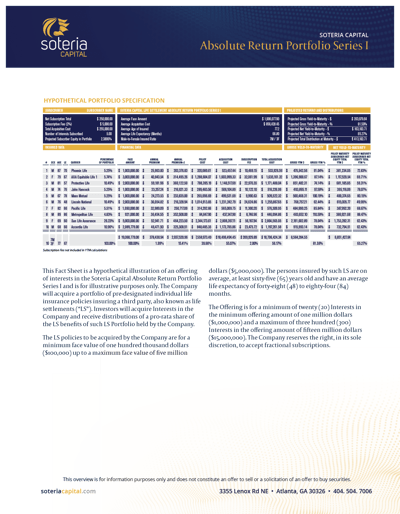Soteria Capital Absolute Return Portfolio Series I
Portfolio Fact Sheet
Greater portfolio diversification and balanced asset allocation with Senior Life Settlements
Here's What You Need to Know
Senior Life Settlements are a life insurance asset-backed security. The investor is buying the surety that comes with a life insurance policy because the payment of its stated death benefit is solely triggered by the mortality of the insured. Virtually all other asset classes depend on a mark-to-market or negotiated price to determine gain or a loss. A life settlement is a contract an investor purchases at a discount to its face value. The discount is the investors' profit margin. Life settlements organically have low correlation to markets and event-driven risk because the capital creation mechanism of a life settlement is unrelated and unaffected to virtually all other asset classes.
The Absolute or Total return refers to the amount of funds that an investment has historically earned in total. The absolute return measures the gain or loss experienced by an asset or portfolio independent of any benchmark or other standard. A life settlement's total acquisition cost and its maturity value is known on the date of purchase. Most other equity asset classes depend on price appreciation to create capital; the absolute or total return is only known when the position is sold. Absolute returns balance volatility risk in asset allocation. In a diversified portfolio of Senior Life Settlements, the investor is purchasing a fractional share of multiple policies populating a portfolio. A portfolio is diversified by including policies differentiated by insured age, gender, life expectancy assessment, face amount and carrier.
1. Time to Maturity
2. Illiquidity
Life settlements have a known cost, a known yield but an uncertain maturity date. It should be expected that some policies will take considerably longer to mature than anticipated. Investors must be Accredited and able to withstand the loss of all or a portion of their principal investment as well as accept there is no liquidity generated from any source other than the maturity of a policy. There are no redemptions. This investment is 100% illiquid. This investment should be considered a long-term buy-and-hold asset class suitable only for well-qualified, sophisticated investors.
A life settlement acts most similar to a zero-coupon bond. The investor purchases a future cash flow at a discount in the form of principal plus accumulated interest paid at the end of the term. Unlike a zero, life settlements have no certain maturity date. To diversify against extension risk, multiple policies populate a portfolio much like a mutual fund. The investor owns a fractional share percentage of each policy's stated death benefit and receives a distribution at each individual policy maturity. Many participants reinvest maturity proceeds into subsequently issued portfolios to increase contract count each representing a payment receivable in the future.
To extract all the value from a life settlement contract, policy selection, underwriting, and a system to manage premium reserves to combat extended longevity risk renders far more value than trading policies in the tertiary market to generate alpha and call it a coupon. The real value is in maximizing the discount to face and understanding exactly what you’re buying as thoroughly and transparently as possible. Along with Capstone Alternative Strategies, we have a vested interest in underwriting the highest quality life settlement contracts possible. We only win when you do.
"Life settlements unquestionably present a suitable means for diversification as they seem to be genuinely uncorrelated with the broader capital markets, geo-politics and mass event risk."
Download the Soteria Capital Absolute Return Fact Sheet
Attractive returns, a conservative risk profile, and low correlation with other asset classes

Subscribe to the Soteria Blog
The Soteria Blog is a short weekly editorial commentary about how life settlements can affect investing and risk management in the current economic and geopolitical environment

